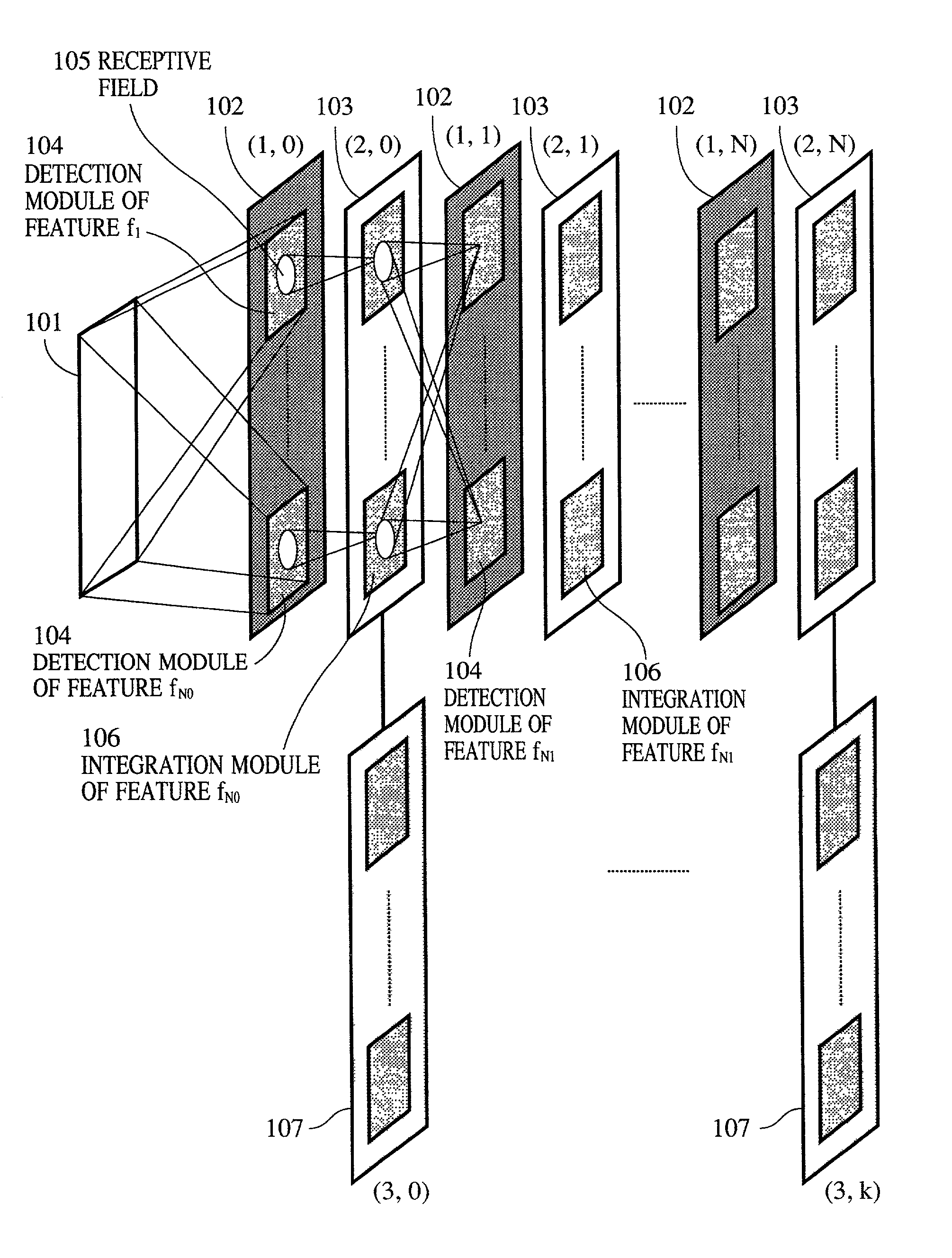Apparatus and method for detecting or recognizing pattern by employing a plurality of feature detecting elements
a technology apparatus, which is applied in the field of apparatus and method for detecting or recognizing patterns by employing a plurality of feature detecting elements, can solve the problems of limited information processing capability, no methods available, and application limitation to the processing of digital representations of information, so as to improve the information processing capability for detecting patterns and high accuracy the effect of detection of a predetermined pattern
- Summary
- Abstract
- Description
- Claims
- Application Information
AI Technical Summary
Benefits of technology
Problems solved by technology
Method used
Image
Examples
first embodiment
[0092]A first embodiment in accordance with the present invention will now be described in detail with reference to the accompanying drawings.
[0093]According to the embodiment, to accomplish pattern recognition by using a neural network, spatial pattern information is represented by using dynamic neural features (e.g., the spatiotemporal firing feature of a spike train, the input feature obtained by spatiotemporal integration by a neuron, and spike intervals of a spike train) in the time domain. Thus, the information processing capability for recognizing spatial patterns is dramatically improved, making it possible to provide a pattern detecting apparatus capable of achieving highly accurate detection by using a smaller circuit scale.
Overview of General Configuration
[0094]FIG. 1 shows a general construction of a pattern detecting or recognizing apparatus according to the embodiment. In this apparatus, pattern information is processed by a What pathway and a Where pathway. The What p...
second embodiment
[0216]In the first embodiment, synapses have been configured to carry out phase modulation. In this embodiment, the recognition of a graphic pattern or the like is performed using a network constituted by synapse elements that modulate pulse widths in analog values and integrate-and-fire neurons shown in the first embodiment in the network configuration shown in FIG. 1.
[0217]The modulation by a synapse is expressed by Wa=SijWb when the pulse width of a pre-synaptic signal is denoted as Wb, and the pulse width of a post-synaptic signal is denoted as Wa. In this case, Sij means the same as the connection strength in expression (5) of the first embodiment. To take a wide dynamic range for the modulation, the basic pulse width of a pulse signal must be set to a value that is sufficiently smaller than the period, i.e., a basic pulse interval.
[0218]A neuron fires or outputs a pulse when its potential exceeds a predetermined threshold value because of the charges accumulated due to the inf...
third embodiment
[0223]The feature detection neurons used in this embodiment are adapted to detect graphic features and their deformation on the basis of the time intervals in analog values and the orders of pulse arrivals, or detect graphic features on the basis of the levels of importance, which will be described hereinafter.
[0224]The network configuration used in this embodiment is the same as that shown in FIG. 1 except that a phase offset based on the location in a receptive field is imparted to each interlayer synaptic connection. FIG. 13 shows a sampling structure in the receptive field of a feature detection neuron employed in this embodiment. For example, if the receptive field is elliptical, as shown in FIG. 13, then the sampling structure is configured such that the phase modulation amounts at lattice points (S1, S2 . . . ) that are spirally sampled from the center position of the ellipse gradually increase. The phase modulation amount at an arbitrary point is defined as the phase modulat...
PUM
 Login to View More
Login to View More Abstract
Description
Claims
Application Information
 Login to View More
Login to View More - R&D
- Intellectual Property
- Life Sciences
- Materials
- Tech Scout
- Unparalleled Data Quality
- Higher Quality Content
- 60% Fewer Hallucinations
Browse by: Latest US Patents, China's latest patents, Technical Efficacy Thesaurus, Application Domain, Technology Topic, Popular Technical Reports.
© 2025 PatSnap. All rights reserved.Legal|Privacy policy|Modern Slavery Act Transparency Statement|Sitemap|About US| Contact US: help@patsnap.com



